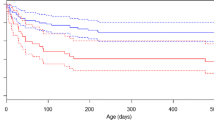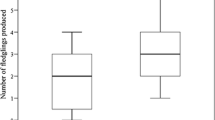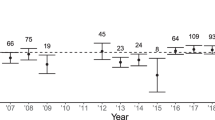Abstract
Universal predictions on the occurrence of cooperative breeding are still elusive. This breeding strategy is strongly linked to phylogeny; therefore, studies on species within groups where cooperative breeding is more prevalent could improve our understanding. Many diurnal raptors exhibit cooperative breeding, although occurrence rates are mostly based on anecdotal observations at nests. Here, we present a detailed study of the reproductive output and social organisation of the African pygmy falcon. Using data from six breeding seasons, we found helpers at 19% of nests. Helper presence had a positive effect on the body condition of the chicks as brood size increased, likely due to their contribution to feeding the chicks. Cooperative breeding groups were more likely to occur following years of higher reproductive output. Indeed, most of the helpers (77%) were non-dispersed offspring from the previous year, whereas the other helpers were immigrant adults (23%). We identified groups that included retained offspring (46%), immigrant adults (27%) or both types of helpers (27%). Breeding groups were also described as multi-male (65%), multi-female (26%) and multi-male-female (9%). Pygmy falcon group composition proved to be highly variable and diverse compared to other raptor species, in which helpers are generally unrelated adult males, showing that selection pressures leading to group formation in diurnal raptors may be more diverse than previously thought.
Significance statement
Cooperative breeding occurs when more than two individuals contribute to raising a brood of young. It occurs in approximately 9% of bird species and it is particularly frequent in diurnal raptors. We studied the breeding performance and social organisation of the African pygmy falcon and found that they form breeding groups at 19% of the nests. These breeding groups included the breeding pair plus helpers that are either males or females. Helpers were also either adult immigrants or retained offspring. We also found that groups produced healthier fledglings than pairs and that groups are more likely to occur following years with high fledgling success. With this work, we expand the number of studies on raptor cooperative breeding and explore the fitness advantages of group breeding in this species as well as the mechanisms behind group formation.


Similar content being viewed by others
References
Arnold KE (1999) Cooperative breeding in birds: the role of ecology. Behav Ecol 10:465–471
Arnold KE, Owens IPF (1998) Cooperative breeding in birds: a comparative test of the life history hypothesis. Proc R Soc Lond B 265:739–745
Bates D, Mächler M, Bolker BM, Walker SC (2015) Fitting linear mixed-effects models using lme4. J Stat Softw 67:1–48
Bednarz JC (1987) Pair and group reproductive success, polyandry, and cooperative breeding in Harris’ hawks. Auk 104:393–404
Bednarz JC (1988) Cooperative hunting Harris’ hawks (Parabuteo unicinctus). Science 239:1525–1527
Bergmüller R, Johnstone RA, Russell AF, Bshary R (2007) Integrating cooperative breeding into theoretical concepts of cooperation. Behav Process 76:61–72
Bertran J, Margalida A (2002) Social organization of a trio of bearded vultures (Gypaetus barbatus): sexual and parental roles. J Raptor Res 36:66–70
Brosnan SF, Bshary R (2010) Cooperation and deception: from evolution to mechanisms. Phil Trans R Soc B 365:2593–2598. https://doi.org/10.1098/rstb.2010.0155
Brown JL, Brown ER (1981) Kin selection and individual fitness in babblers. In: Alexander RD, Tinkle DW (eds) Natural selection and social behavior. Chiron, New York, pp 244–256
Canestrari D, Marcos JM, Baglione V (2008) Reproductive success increases with group size in cooperative carrion crows, Corvus corone corone. Anim Behav 75:403–416
Clum NJ (1995) Effects of aging and mate retention on reproductive success of captive female peregrine falcons. Integr Comp Biol 35:329–339. https://doi.org/10.1093/icb/35.4.329
Cockburn A (2006) Prevalence of different modes of parental care in birds. Proc R Soc Lond B 273:1375–1383
Cornwallis CK, Botero CA, Rubenstein DR, Downing PA, West SA, Griffin AS (2017) Cooperation facilitates the colonization of harsh environments. Nat Ecol Evol 1:0057. https://doi.org/10.1038/s41559-016-0057
Covas R and du Plessis MA (2005) The effect of helpers on artificially increased brood size in sociable weavers (Philetairus socius). Behav Ecol Sociobiol 57:631–636
Covas R, Du Plessis MA and Doutrelant C (2008) Helpers in colonial cooperatively breeding sociable weavers Philetairus socius contribute to buffer the effects of adverse breeding conditions. Behav Ecol Sociobiol 63:103–112
Dias RI, Webster MS, Macedo RH (2015) Helping enhances productivity in campo flicker (Colaptes campestris) cooperative groups. Sci Nat 102:31
Du Plessis MA, Siegfried WR, Armstrong AJ (1995) Ecological and life history correlates of cooperative breeding in South African birds. Oecologia 102:180–188
Edwards SV, Naeem S (1993) The phylogenetic component of cooperative breeding in perching birds. Am Nat 141:754–789
Emlen ST (1982) The evolution of helping. I An ecological constraints model. Am Nat 119:29–39
Emlen ST (1991) Evolution of cooperative breeding in birds and mammals. In: Krebs R, Davies NB (eds) Behavioural ecology: an evolutionary approach. Blackwell Scientific, Oxford, pp 301–335
Emlen ST and Wrege PH (1991) Breeding biology of White-fronted Bee-eaters at Nakuru: The influence of helpers on breeder fitness. J Anim Ecol 60:309–326
Faaborg J (1986) Reproductive success and survivorship of the Galapagos hawk Buteo galapagoensis: potential costs and benefits of cooperative polyandry. Ibis 128:337–347. https://doi.org/10.1111/j.1474-919X.1986.tb02684.x
Faaborg J, Bednarz J (1990) Galapagos and Harris’ hawks: divergent causes of sociality in two raptors. In: Stacey PB, Koenig WD (eds) Cooperative breeding in birds: long term studies of ecology and behaviour. Cambridge University Press, Cambridge, pp 357–384
Faaborg J, Vries T, Patterson CB, Griffin CR (1980) Preliminary observations on the occurrence and evolution of polyandry in the Galapagos hawk (Buteo galapagoensis). Auk 97:581–590
Faaborg J, Parker PG, DeLay L, de Vries T, Bednarz JC, Maria Paz S, Naranjo J, Waite TA (1995) Confirmation of cooperative polyandry in the Galapagos hawk (Buteo galapagoensis). Behav Ecol Sociobiol 36:83–90
Ford HA, Bell H, Nias R, Noske R (1988) The relationship between ecology and the incidence of cooperative breeding in Australian birds. Behav Ecol Sociobiol 22:239–249
Garcelon DK, Slater GL, Danilson CD, Helm RC (1995) Cooperative nesting by a trio of bald eagles. J Raptor Res 29:210–213
Hamilton W (1964) The genetical evolution of social behaviour. J Theor Biol 7:1–52
Hatchwell BJ (1999) Investment strategies of breeders in avian cooperative breeding systems. Am Nat 154:205–219
Hatchwell BJ, Russell AF, MacColl ADC, Ross DJ, Fowlie MK, McGowan A (2004) Helpers increase long-term but not short-term productivity in cooperatively breeding long-tailed tits. Behav Ecol 15:1–10
Heinsohn R and Cockburn A (1994) Helping is costly to young birds in cooperatively breeding White-winged Choughs. Proc R Soc B 256:293–298
Heredia R, Donázar J (1990) High frequency of polyandrous trios in an endangered population of lammergeiers Gypaetus barbatus in Northern Spain. Biol Conserv 53:163–171. https://doi.org/10.1016/0006-3207(90)90083-2
Jetz W, Rubenstein DR (2011) Environmental uncertainty and the global biogeography of cooperative breeding in birds. Curr Biol 21:72–78. https://doi.org/10.1016/j.cub.2010.11.075
Kimball RT, Parker PG, Bednarz JC (2003) Occurrence and evolution of cooperative breeding among the diurnal raptors (Accipitridae and Falconidae). Auk 120:717–729
Kingma SA, Santema P, Taborsky M, Komdeur J (2014) Group augmentation and the evolution of cooperation. Trends Ecol Evol 29:476–484
Koenig WD, Dickinson J (2004) Ecology and evolution of cooperative breeding in birds. Cambridge University Press, Cambridge
Krochuk BA, Bolopo D, Lowney A, Meyers PR, Spottiswoode CN, Raman RMG, Thomson RL (2018) Why defaecate on your doorstep? Investigating an unusual behaviour in Africa’s smallest falcon. Ostrich (published online. https://doi.org/10.2989/00306525.2018.1529001)
Labocha MK, Hayes JP (2012) Morphometric indices of body condition in birds: a review. J Ornithol 153:1–22
Lenth RV (2016) Least-squares means: the R package lsmeans. J Stat Softw 69:1–33. https://doi.org/10.18637/jss.v069.i01
Lowney A, Green K, Ngomane BP, Thomson RL (2017) Mortal combat: intraspecific killing by an African pygmy-falcon ( Polihierax semitorquatus ) to acquire new mate and territory. J Raptor Res 51:89–91. https://doi.org/10.3356/JRR-16-64.1
Maclean GL (1970) The pygmy falcon Polihierax semitorquatus. Koedoe 13:1–22
Maclean GL (1973) The sociable weaver, part 4: predators, parasites and symbionts. Ostrich 44:241–253
Malan G (1998) Solitary and social hunting in pale chanting goshawk (Melierax canorus) families: why use both strategies? J Raptor Res 32:195–201
Malan G (2004) The relative influence of prey abundance and co-breeders on the reproductive performance of polyandrous pale chanting-goshawks. Ostrich 75:44–51. https://doi.org/10.2989/00306520409485411
Malan G, Jenkins AR (1996) Territory and nest defence in polyandrous pale chanting goshawks: do co-breeders help ? S Afr J Zool 31:170–176
Malan G, Crowe TM, Biggs R, Herholdt JJ (1997) The social system of the pale chanting goshawk Melierax canorus; monogamy v polyandry and delayed dispersal. Ibis 139:313–321. https://doi.org/10.1111/j.1474-919X.1997.tb04630.x
Moreno J, Merino S, Sanz JJ, Arriero E, Morales J, Tomás G (2005) Nestling cell-mediated immune response, body mass and hatching date as predictors of local recruitment in the pied flycatcher Ficedula hypoleuca. J Avian Biol 36:251–260. https://doi.org/10.1111/j.0908-8857.2005.03413.x
Murgatroyd M, Underhill LG, Rodrigues L, Amar A (2016) The influence of agricultural transformation on the breeding performance of a top predator: Verreaux’s eagles in contrasting land use areas. Condor 118:238–252. https://doi.org/10.1650/CONDOR-15-142.1
Parker JW, Ports M (1982) Helping at the nest by yearling Mississippi kites. J Raptor Res 16:14–17
R Development Core Team (2010) R: a language and environment for statistical computing. R Foundation for Statistical Computing, Vienna http://www.R-project.org
R Development Core Team (2017) R: a language and environment for statistical computing. R Foundation for Statistical Computing, Vienna http://www.R-project.org
Riehl C (2013) Evolutionary routes to non-kin cooperative breeding in birds. Phil Trans R Soc B 280:20132245
Rodríguez S, van Noordwijk AJ, Alvarez E, Barba E (2016) A recipe for postfledging survival in great tits Parus major: be large and be early (but not too much). Ecol Evol 6:4458–4467. https://doi.org/10.1002/ece3.2192
Rubenstein DR, Lovette IJ (2007) Temporal environmental variability drives the evolution of cooperative breeding in birds. Curr Biol 17:1414–1419
Russell E, Rowley I (1988) Helper contributions to reproductive success in the splendid fairy-wren (Malurus splendens). Behav Ecol Sociobiol 22:131–140
Shen S-F, Emlen ST, Koenig WD, Rubenstein DR (2017) The ecology of cooperative breeding behaviour. Ecol Lett 20:708–720
Spottiswoode C, Herrmann E, Rasa OAE, Sapsford CW (2004) Co-operative breeding in the pygmy falcon Polihierax semitorquatus. Ostrich 75:322–324
Taborsky M (1994) Sneakers, satellites, and helpers: parasitic and cooperative behavior in fish reproduction. Adv Stud Behav 23:1–100
Tella JL (1993) Polyandrous trios in a population of Egyptian vultures. J Raptor Res 27:119–120
Thomsett S (1991) Polyandrous pygmy falcons? Gabar 6:73
Valencia J, Solís E, Sorci G, de la Cruz C (2006) Positive correlation between helpers at nest and nestling immune response in a cooperative breeding bird. Behav Ecol Sociobiol 60:399–404
Venables WN, Ripley BD (2002) Modern applied statistics with S, 4th edn. Springer, New York
Watson RT, Razafindramanana S, Thorstrom R, Rafanomezantsoa S (1999) Breeding biology, extra-pair birds, productivity, siblicide and conservation of the Madagascar fish eagle. Ostrich 70:105–111. https://doi.org/10.1080/00306525.1999.9634522
Acknowledgments
We thank the Oppenheimer family, Tswalu Foundation and Tswalu Kalahari for permitting us to conduct research on their property. We thank also Anna Gamero for comments on previous versions of this manuscript and Arjun Amar for help with statistical analyses. Thanks to Stephen Pruett-Jones, Christie Riehl and Jim Bednarz for their review and helpful suggestions to improve the manuscript.
Funding
The field work was funded by the NRF-DST Centre of Excellence of the FitzPatrick Institute of African Ornithology and by a Tswalu Foundation grant. RLT was initially supported by the Academy of Finland (grant no. 138049) and the University of Turku Collegium for Science and Technology grant for this work.
Author information
Authors and Affiliations
Corresponding author
Ethics declarations
Conflict of interest
The authors declare that they have no conflict of interest.
Ethical approval
The project conformed to the legal requirements of South Africa and has received research FAUNA permits from the Northern Cape Province’s Department of Environment and Nature Conservation, and an ethics approval from the Science Animal Ethics Committee (SFAEC) of the University of Cape Town, South Africa.
Additional information
Communicated by S. Pruett-Jones
Publisher’s Note
Springer Nature remains neutral with regard to jurisdictional claims in published maps and institutional affiliations.
Rights and permissions
About this article
Cite this article
Bolopo, D., Lowney, A.M. & Thomson, R.L. Helpers improve fledgling body condition in bigger broods of cooperatively breeding African pygmy falcon. Behav Ecol Sociobiol 73, 16 (2019). https://doi.org/10.1007/s00265-018-2630-3
Received:
Revised:
Accepted:
Published:
DOI: https://doi.org/10.1007/s00265-018-2630-3




